A $100 3D-printed PDK distance sensor?
#241
Well done and thank you thank you thank you!!!!!
The following users liked this post:
jtsherri (06-27-2024)
#242
Rennlist Member
You can count me in to purchase one of both of those sensors when available to purchase. That should "guarantee" that my PDK will never fail! LOL
Great job to everyone (and their wives!) who pursued this engineering and manufacturing challenge!
Great job to everyone (and their wives!) who pursued this engineering and manufacturing challenge!
The following 3 users liked this post by Viper pilot:
#243
This thread is pretty incredible. It encapsulates everything that's great about Rennlist. People are taking on challenges with our cars in a thoughtful, data-based manner, with feedback from other smart members along the way. Thanks to everyone who's contributed along the way. I hope this sensor gets out to the public soon. Unfortunately, it won't be soon enough for me since I want to get my 987.2 Cayman back on the track this summer. So a couple of questions for the braintrust:
1) Does anyone see any meaningful differences in the sensors third-party manufacturers offer? Some require less soldering by the technician (fewer points of future failure), which seems like a positive. It sounds like the OP identified some differences in the sensors, the circuit, and the calibration approaches. Is there anything to be aware of before purchasing? Feel free to PM me if you don't feel comfortable sharing your opinion publicly.
2) There was quite a bit of useful conversation about the calibration approach and potential pitfalls. Any thoughts on the best approach? The point about battery disconnection is subtle and I haven't seen others mention it.
1) Does anyone see any meaningful differences in the sensors third-party manufacturers offer? Some require less soldering by the technician (fewer points of future failure), which seems like a positive. It sounds like the OP identified some differences in the sensors, the circuit, and the calibration approaches. Is there anything to be aware of before purchasing? Feel free to PM me if you don't feel comfortable sharing your opinion publicly.
2) There was quite a bit of useful conversation about the calibration approach and potential pitfalls. Any thoughts on the best approach? The point about battery disconnection is subtle and I haven't seen others mention it.
#244
This thread is pretty incredible. It encapsulates everything that's great about Rennlist. People are taking on challenges with our cars in a thoughtful, data-based manner, with feedback from other smart members along the way. Thanks to everyone who's contributed along the way. I hope this sensor gets out to the public soon. Unfortunately, it won't be soon enough for me since I want to get my 987.2 Cayman back on the track this summer. So a couple of questions for the braintrust:
1) Does anyone see any meaningful differences in the sensors third-party manufacturers offer? Some require less soldering by the technician (fewer points of future failure), which seems like a positive. It sounds like the OP identified some differences in the sensors, the circuit, and the calibration approaches. Is there anything to be aware of before purchasing? Feel free to PM me if you don't feel comfortable sharing your opinion publicly.
2) There was quite a bit of useful conversation about the calibration approach and potential pitfalls. Any thoughts on the best approach? The point about battery disconnection is subtle and I haven't seen others mention it.
1) Does anyone see any meaningful differences in the sensors third-party manufacturers offer? Some require less soldering by the technician (fewer points of future failure), which seems like a positive. It sounds like the OP identified some differences in the sensors, the circuit, and the calibration approaches. Is there anything to be aware of before purchasing? Feel free to PM me if you don't feel comfortable sharing your opinion publicly.
2) There was quite a bit of useful conversation about the calibration approach and potential pitfalls. Any thoughts on the best approach? The point about battery disconnection is subtle and I haven't seen others mention it.
I'm going to go into a bit of technical detail below of magnetic flux patterns etc, so I hope I don't put people to sleep.
I have had a Chinese copy sensor in my hands to test over the last few weeks courtesy of a workshop in Malaysia I was helping fix a 718 PDK problem. The fella from the workshop was flying into Australia so he drove to my house and we tested sensors and talked PDK for a day. They'd replaced a failed OEM sensor with this one, and were still having problems. Without going into all the details, the response didn't resemble an OEM sensor response in any respect. Freq and PWM output were all over the place for all channels. I really couldn't work out what was going on. I think these sensors are an attempted copy of the OEM sensor. The plug wasn't OEM and the pins were narrower than OEM. The workshop solved the issue by purchasing a second hand OEM sensor on ebay that worked fine.
Both the T design, Xemodex and our sensor use programmable Hall Effect sensors, which are a modern component that are very robust and reliable. The OEM sensor uses a collection of different components that work very well as a sensor when you look at the details of its output, but are seriously prone to failure as we all know.
T design sensor
The T design sensor from what we can gather uses a center mounted Hall Effect sensor. If you look at the image below that comes from the T design website, you can see how narrow the cavity is for the circuit board and sensors. Hence our assumption that the individual sensors are centrally mounted rather than on the edge.
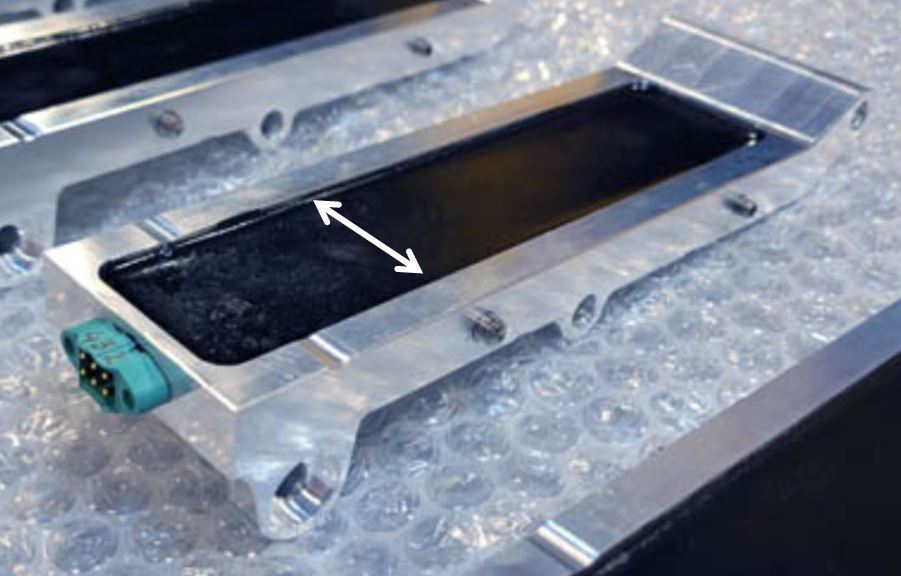
From out testing, using a center mounted sensor presents some difficulties and advantages. The big difficulty is how to deal with the magnet flux changes as the magnet moves with respect to the sensor.
Below is an image that shows the magnetic flux change as a magnet moves over a HE sensor. You can see the center section of the plot that is linear, which is the good part of it that will result in a nice linear response that is needed. The problem is that the linear portion is only when the magnet stays over the sensor for the entire range of movement. The second image shows what this would need to look like, with the magnet being long so it stays over the sensor when it moves. Position 1 is central, with positions 2 & 3 being full deflection in either direction.


But here is the problem. The PDK magnets are a disc that are 10mm across and 6mm thick. So when the magnet moves in relation to the sensor it looks like below, where the magnet edges move well beyond the sensor as the total shift rod movement from one selection to the other is normally about 17mm, up to a maximum of 20mm, which is well beyond the 6mm thickness of the magnet.
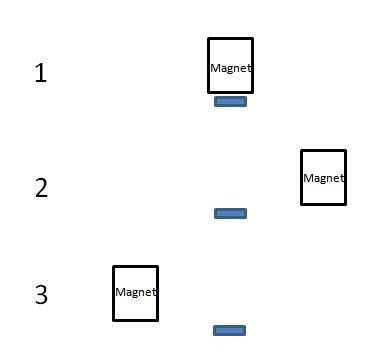
The end result is that the flux the sensor will detect looks like this, and is well outside the linear range.

So this very non linear sensor response then needs to be changed to a very linear PWM sensor output for the TCU to use it correctly. I don't know how T design do this, as the tools within programmable HE sensors we've seen are pretty basic. There might be something completely different going on inside, but enough said that for the reasons above we decided not to go down the path of centrally mounted sensors.
Note that a critical part of sensor response is that it gives a linear PWM response as it moves from the central position to full deflection where the gear is selected. If from the calibration it's expecting an output of 8mm when a gear is selected, the sensor must give a progressive increase to this distance as the magnet moves. If there is a transmission problem, it doesn't shift correctly and the shift rod only moves 6mm rather than the 8mm expected, you need the TCU to see this and respond by not engaging the clutch and do major damage to the transmission. This is why the distance sensor exists in the first place, that being to detect accurately where the shift position is and determine if all is good prior to engaging the a clutch.
Like I said above, I've never had a T design sensor in my hands to test the response, and if they can get a linear response from a center mounted HE sensor then there is some fancy stuff going on to make this happen.
The big advantage to a center mounted sensor is that when you flip it to mount in either a Cayman/Boxster or 911, it's still located in the same position relative to the shift rod magnets.
All six wires for the T design sensor need to be soldered into the existing harness. There is limited wire for this, and the solder joints end up in a place that in my opinion is not optimal. The wire that bends into the sensor needs to be flexible to route correctly, but this is where the T design sensor solder joints will be located. Image from the T design website install instructions below.
The T design distance sensor sells I think for about US$1900. They also sell a speed sensor, I think for around the UD$1500 dollar mark, which also needs to be soldered in.

XemodeX sensor
The Xemodex sensor uses an end mounted sensor. Image below from the Xemodex website. I think this is the sensor also sold by LN Engineering. The arrow points to the channel 4 sensor. The other three channel sensors point down into the housing on the other side of the circuit board.
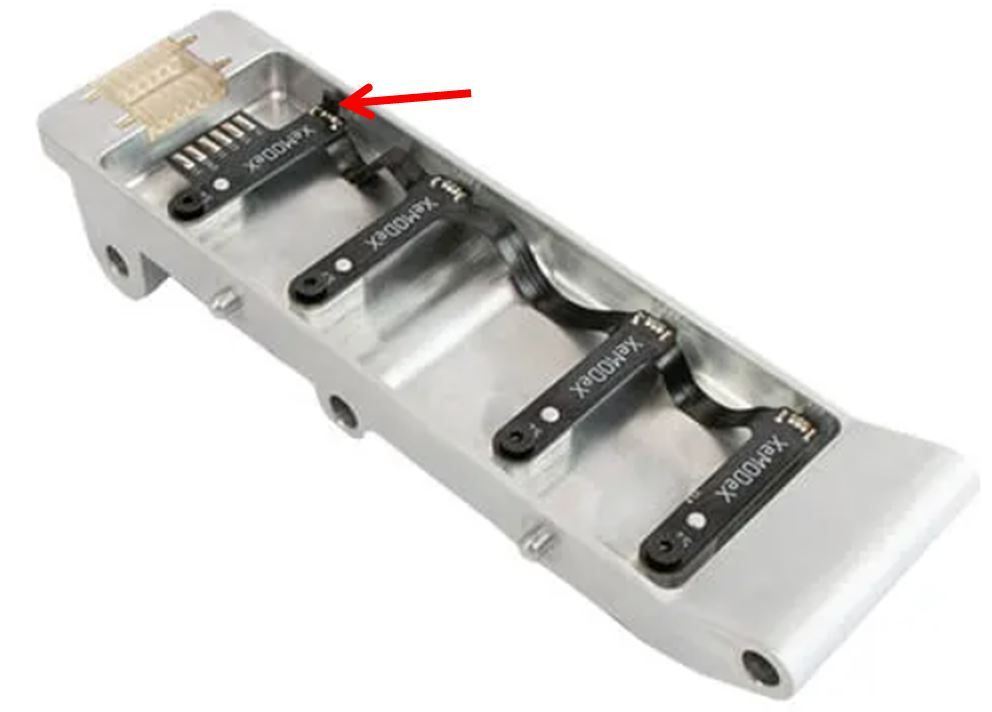
As you can see the sensors are mounted at the end rather than centrally. Why? Because the magnetic flux is much easier to deal with as shown in the plot below. The sensor is now always on one side of the magnet, so it will detect in the non linear region. Whilst this is a curved response, the algorithms within a programmable HE sensor are designed specifically to deal with this and provide a near linear PWM output.
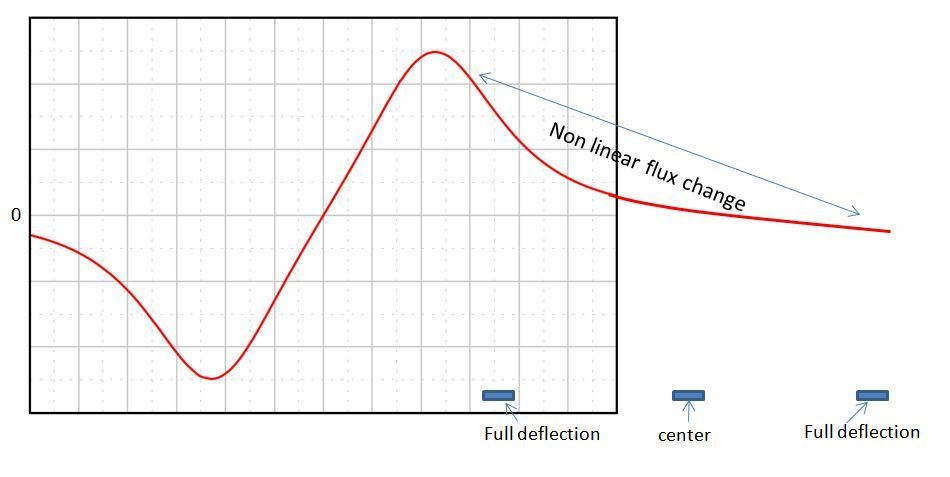
You can see in the image of the Xemodex sensor above that all the sensors are mounted along one edge. In the OEM sensors, the sensors themselves aren't right in the middle. Channels 1, 2, and 4 are offset towards one edge, channel 3 towards the other. So with the XemodeX design this means that channel 3 magnet is sitting pretty much on top of the sensor when 3rd gear is selected. This can be dealt with but is not ideal.
One of the biggest issues is that when you flip it over to mount in a 911. For shift rods 1 and 4, the magnet sits right at the end of the shift rod, with the shift rod made of steel. This has a massive effect on the flux detected by the sensor if the shift rod is between the magnet and sensor.
So in one orientation (Cayman/Boxster) it would look like this. No problems
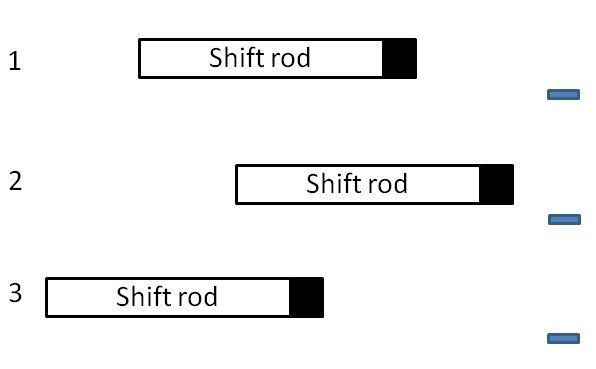
But when flipped to go into the 911 it looks like this. This is going to cause major issues when attempting to achieve a good sensor response because there is a big rod of steel between the magnet and sensor.

I don't know how XemodeX deal with this issue, as we made a version just like this, found the problem and decided it wasn't the way to go.
The XemodeX sensor comes with a plug and you need to solder in the speed sensor. Not ideal but better than having to solder in the distance sensor. It retails on their website for US$2200.
JUMPS PDK distance sensor
This is the one we have designed. We've decided to name it JUMPS after the individuals who have contributed to it. No particular order of the letters. It just made a word in this order when a U was added.
J - Jjrichar
U
M - Muddtt
P - PV997
S - Stjoh
So the sensor we have designed is going to have two different versions. They both use end mounted sensors with channel 3 put on the other side to the other three. One version for the Cayman/Boxster, and the other for the 911 has the circuit board flipped over and the sensors mounted in a way that results in identical geometry of the individual sensors relative to the transmission components. I hope it's obvious from the discussion above why we have done this.
Note that what I've talked about above is just scratching the surface. There is far more complexity to it when you change how each individual sensor is mounted take into account the interference from other ferrous objects, adjacent magnet interference, magnet strength changes with temperature, etc, etc. All this combined with some fancy maths (my maths degree from 35 years ago came in very handy) and in the end you end up with a sensor that is very consistent for every channel throughout the whole range.
But the downside is that a Boxster/Cayman sensor won't work on a 911 transmission. We made this 'two version' design decision based on wanting to create a sensor that gave the most consistent response we could manage. If someone needs a distance sensor they can swap between different car types then ours won't work for them. But from my experience, if I have broken car I just want to buy a part that fixes it. I don't need it to be swapped to another car type that I don't own.
One of the things we have really worked on is making the install much easier so no soldering is required. Our sensor will have the wiring, plastic protective sheath and OEM pins installed. It's then a very simple procedure of tapping out the old pins from the plug and installing the new. I've spoken at length with workshops who replace the sensors, and one of the big ticket items to them was not having to solder in a new sensor due to the risks associated with heat cycles and oil soaked (with ferrous contamination) environment, not to mention the extra time. It's take a lot of time to source the parts but this is something we thought was worth the effort.
I'm also doing testing for the speed sensor, which I expect to have completed soon. We are also sourcing the OEM pin housing (the plug) so we will be able to offer a sensor that is a complete remove/replace item. Unfortunately getting the plugs requires a minimum buy of about AU$5000, which is a bit steep at this stage of the project. I'm hoping this full sensor pack (distance + speed sensor) including plug might be available some time next year.
You are probably aware that the reason we developed the sensor was because we thought the other options were very over-priced for what they are. The price of our sensor will be around the US$500 mark with the speed sensor being about the same when it comes along. When I can get my hands on plugs and offer the whole thing it will be about the US$1000 mark. I don't know exactly what people want at this stage, but the workshops I've spoken to have made it clear that a complete remove/replace with no soldering is by far the preferred option.
With respect to calibrations, I've not heard anything about the battery disconnect. The only advice I can offer you is to not do the 'with part replacement' routine. Only do the 'without previous part replacement' routine. The distance sensor cal part of each is the same, but the additional stuff done in the 'with part replacement' routine can easily fail and be very difficult to rectify.
Last edited by jjrichar; 07-15-2024 at 04:21 AM.
The following users liked this post:
Prairiedawg (07-14-2024)
The following users liked this post:
J.Correa (08-03-2024)
#246
Also looking forward to proactively buying these sensors in the hopes I'll never have to use them haha.
#247
Basic Sponsor
Rennlist
Site Sponsor
Rennlist
Site Sponsor
Also, sometimes it's not obvious but the biggest expense in this particular type of repair is installation. Taking PDK down, opening it correctly and calibrating after take a lot of labor, and a lot of experience. Therefore choosing the right repair shop that can do the job in one try - is incredibly important.
We work with repair shops in US and all over the world and can help you to choose one.
https://t-design9.com/porsche_PDK_di...on_sensor.html
__________________
T-Design9 : Mods and ergonomic accessories bespoke designed for Porsche cars
Memory Modules : remember SC **** settings; A/S/S, PSE, Spoiler, Sport/+ buttons
Phone Mounts : keep your phone up and close and charged
Cupdholders, Sunglass Holsters and more at T-Design9.com
T-Design9 : Mods and ergonomic accessories bespoke designed for Porsche cars
Memory Modules : remember SC **** settings; A/S/S, PSE, Spoiler, Sport/+ buttons
Phone Mounts : keep your phone up and close and charged
Cupdholders, Sunglass Holsters and more at T-Design9.com
Last edited by t-design; 08-28-2024 at 04:33 PM.
#248
My first post on any of the forums as I've always had cars that didn't require in depth knowledge when it came to faults. Long story short, a few years ago I got a 981 boxter gts for a few days in exchange for a brake service on one of the customer's cars. I fell in love with the car so a few years later I made my dream come true and bought my first porsche 2019 981 cayman s. A crashed one (since i'm on a budget), it took the shop 4 months to fix it (absentee workers issue, it was an easy crash but still needed some metal/aluminum work as the rear quarter plate was quite bent).
Anyway, now 4 weeks after being roadworthy to drive and enjoying it, the P0652 error came on and the almighty “Possible R gear fault. Driving allowed'' accured. Cleared the codes, it was fine for a day and today it came back up....
I started doing a little research and found out that the speed/distance sensors are a big problem. I've found T-desing and other aftermarket deals for these parts but I'm still hoping to find better alternatives and just now found this thread and a lot of the burden has been lifted off me seeing how much enthusiasm and level of engineering @PV997 @jjrichar have done approaching this problem. Thread started in 2022 and I took 2 hours of reading to study it, and I was sure that by the endy the solution would already be given and proven. But I can see that's not the case, it just goes to show you how much effort some people will put in for others and end up giving it almost for free so that people like me and others can benefit.
I have to fix my car so I may not enjoy the fruits of this hard work @PV997, @jjrichar and @stjoh have put in, but I still want to thank you. When this project is done, I know a lot of people will be in the same situation as me and will be very grateful for the solution you will offer. I wish you good health @PV997, in the end that's what matters most.
Sorry for my bad English, I'm from Europe and it's my second language.
Nejc Grozde
Anyway, now 4 weeks after being roadworthy to drive and enjoying it, the P0652 error came on and the almighty “Possible R gear fault. Driving allowed'' accured. Cleared the codes, it was fine for a day and today it came back up....
I started doing a little research and found out that the speed/distance sensors are a big problem. I've found T-desing and other aftermarket deals for these parts but I'm still hoping to find better alternatives and just now found this thread and a lot of the burden has been lifted off me seeing how much enthusiasm and level of engineering @PV997 @jjrichar have done approaching this problem. Thread started in 2022 and I took 2 hours of reading to study it, and I was sure that by the endy the solution would already be given and proven. But I can see that's not the case, it just goes to show you how much effort some people will put in for others and end up giving it almost for free so that people like me and others can benefit.
I have to fix my car so I may not enjoy the fruits of this hard work @PV997, @jjrichar and @stjoh have put in, but I still want to thank you. When this project is done, I know a lot of people will be in the same situation as me and will be very grateful for the solution you will offer. I wish you good health @PV997, in the end that's what matters most.
Sorry for my bad English, I'm from Europe and it's my second language.
Nejc Grozde
The following users liked this post:
SpectreH (08-28-2024)
#249
My first post on any of the forums as I've always had cars that didn't require in depth knowledge when it came to faults. Long story short, a few years ago I got a 981 boxter gts for a few days in exchange for a brake service on one of the customer's cars. I fell in love with the car so a few years later I made my dream come true and bought my first porsche 2019 981 cayman s. A crashed one (since i'm on a budget), it took the shop 4 months to fix it (absentee workers issue, it was an easy crash but still needed some metal/aluminum work as the rear quarter plate was quite bent).
Anyway, now 4 weeks after being roadworthy to drive and enjoying it, the P0652 error came on and the almighty “Possible R gear fault. Driving allowed'' accured. Cleared the codes, it was fine for a day and today it came back up....
I started doing a little research and found out that the speed/distance sensors are a big problem. I've found T-desing and other aftermarket deals for these parts but I'm still hoping to find better alternatives and just now found this thread and a lot of the burden has been lifted off me seeing how much enthusiasm and level of engineering @PV997 @jjrichar have done approaching this problem. Thread started in 2022 and I took 2 hours of reading to study it, and I was sure that by the endy the solution would already be given and proven. But I can see that's not the case, it just goes to show you how much effort some people will put in for others and end up giving it almost for free so that people like me and others can benefit.
I have to fix my car so I may not enjoy the fruits of this hard work @PV997, @jjrichar and @stjoh have put in, but I still want to thank you. When this project is done, I know a lot of people will be in the same situation as me and will be very grateful for the solution you will offer. I wish you good health @PV997, in the end that's what matters most.
Sorry for my bad English, I'm from Europe and it's my second language.
Nejc Grozde
Anyway, now 4 weeks after being roadworthy to drive and enjoying it, the P0652 error came on and the almighty “Possible R gear fault. Driving allowed'' accured. Cleared the codes, it was fine for a day and today it came back up....
I started doing a little research and found out that the speed/distance sensors are a big problem. I've found T-desing and other aftermarket deals for these parts but I'm still hoping to find better alternatives and just now found this thread and a lot of the burden has been lifted off me seeing how much enthusiasm and level of engineering @PV997 @jjrichar have done approaching this problem. Thread started in 2022 and I took 2 hours of reading to study it, and I was sure that by the endy the solution would already be given and proven. But I can see that's not the case, it just goes to show you how much effort some people will put in for others and end up giving it almost for free so that people like me and others can benefit.
I have to fix my car so I may not enjoy the fruits of this hard work @PV997, @jjrichar and @stjoh have put in, but I still want to thank you. When this project is done, I know a lot of people will be in the same situation as me and will be very grateful for the solution you will offer. I wish you good health @PV997, in the end that's what matters most.
Sorry for my bad English, I'm from Europe and it's my second language.
Nejc Grozde
Last edited by Robb M.; 08-29-2024 at 09:29 AM. Reason: don't post contact info online scammers will attack you.


